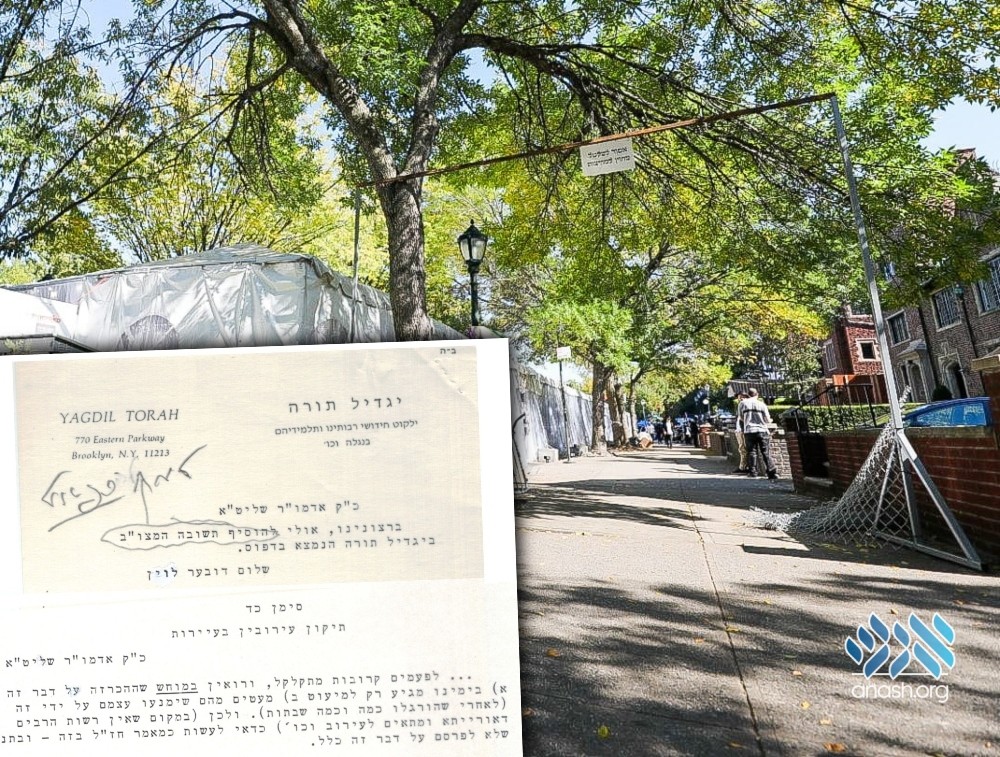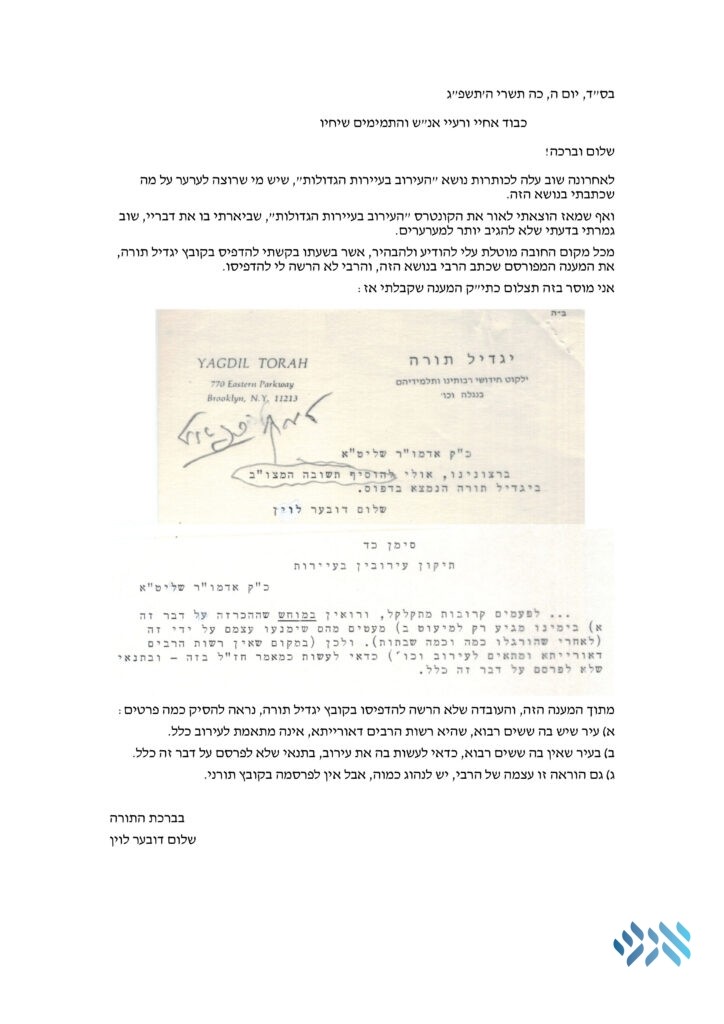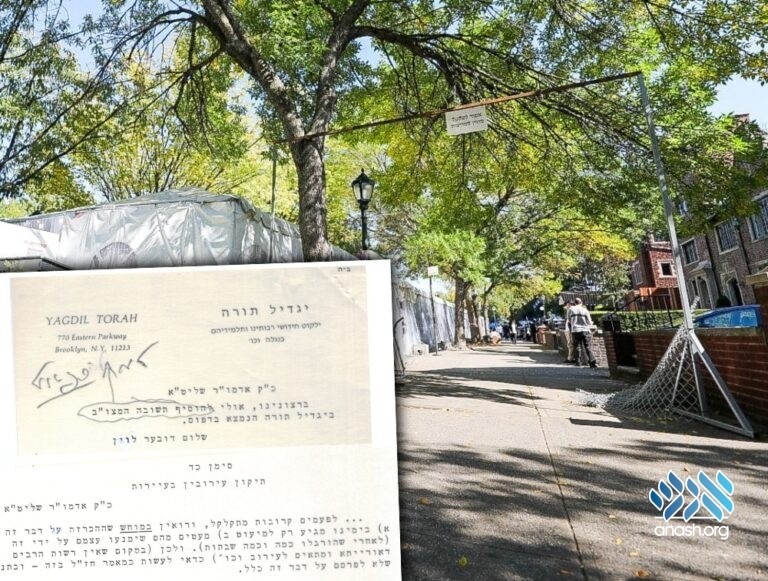כ״ו תשרי ה׳תשפ״ג | October 20, 2022
New Response from the Rebbe Addresses Eruv Question
A never-before-published response from forty years ago, released now by Rabbi Shalom Ber Levine of the Rebbe’s library, clarifies the Rebbe‘s basic requirements for building a city eruv.

A never-before-published response from forty years ago, released now by Rabbi Shalom Ber Levine of the Rebbe’s library, clarifies the Rebbe’s basic requirements for building a city eruv.
By Anash.org reporter
A never-before-published response from forty years ago, released now by Rabbi Shalom Ber Levine of the Rebbe’s library, clarifies the Rebbe‘s requirements for a city eruv.
As is known, the Rebbe had a strong stance on the installation of eruvin in large cities. Aside from the halachic impossibility of making a string eruv in a city with 600,000 people (reshus harabim), the Rebbe had multiple concerns about the issues that a city eruv can bring. This new maineh, clarifies some of those concerns and spell out the Rebbe’s two basic requirements for an eruv: (a) that it is not a reshus harabim and (b) that the place is deemed appropriate for an eruv.
In a conversation with Anash.org, Rabbi Levine explained the context of the response.
“In my work on the Yagdil Torah journal,” Rabbi Levine shared, “I had collected various halachic writings by the Rebbe to include in the publication. Before each publication, I would submit my suggested submissions to the Rebbe for approval.
“In 5742 (1982), I submitted a response that the Rebbe had written on the requirements for eruv in a city, delineating that it not be a reshus harabim and that the place be suitable. Obviously, the Rebbe recognized that there are in fact reshus harabim nowadays and felt the need to specify that as an issue that must be avoided.
“Even when those conditions were met, the Rebbe expressed concern that people would continue carrying when the eruv is broken, and therefore allowed it to be built only in complete secrecy.
“When I submitted this piece to the Rebbe, the Rebbe acknowledged it, but wrote not to include it in the Torah journal.”
The following is a translation of the Rebbe’s halachic response:
“Oftentimes the eruv breaks, and we see clearly that an announcement about this (a) nowadays only reaches a minority of the community (b) few of those will abstain from carrying because of this (after having gotten used to carrying for many Shabbosos). Therefore (in a place where there is no reshus harabim and it is suitable for an eruv etc.) it is worthwhile to build one as Chazal say – on condition not to publicize this at all.”



There are no longer any questions about the Rebbe’s opinion. The Rebbe held that an eruv in NYC is halachically impossible and was not fond of eruvs in any large city.
It’s astounding how some people will twist the Rebbe’s words in every which way to get what they want.
Let’s be honest and faithful to the Rebbe’s words.
The “Eruv rav” isn’t quitting so fast. He will come up with convoluted arguments that “It’s not what the Rebbe meant, and the Rebbe changed his mind, and times have changed, and the Rebbe wasn’t talking about New York etc. etc.”
But “chassidim hubben a chush horeiach” and they can smell who is authentic and who is not.
Unfortunately very true.
As chasidim of the Rebbe, we MUST uphold the Rebbe’s authority.
Yagdil Torah was published by the Kolel and, if my memory serves me well, R’ Heller taught Hilchos Eiruvin be’iyun in Kolel around that time.
What I find most interesting about this letter is that the Rebbe says clearly that even if there are NOT 600,000 the eruv should be made secretly.
When there ARE 600,000, the Rebbe says not to make one AT ALL!
The Rebbe says nothing about a city with or without 600,000 people. That comes from the author who draws his own conclusions.
The Rebbe clearly holds that most cities are NOT a reshus horabim min Hatora, and that includes NYC. Having 600,000 people in the city does not automatically deem the city a reshus horabim. There are other conditions that are needed before it can qualify as a Reshus Horabim.
The only objections the Rebbe has, are that the eruv may have been made by someone that is incompetent, and that even in a good eruv, there is a concern that it may break and people will continue to carry out of habit.
“The Rebbe clearly holds that most cities are NOT a reshus horabim min Hatora, and that includes NYC.”
That is both untrue and ridiculous. The Rebbe never said that and it is ridiculous to say that one of the most populated cities in the world is not a reshus horabim.
Can someone please explain clearly what a reshus harabbim is? Also, is there any form of acceptable eruv for a reshus haraabim ? Where is an eruv acceptable and what material?
A reshus horabim means a public area used by 600,000 (or according to some any street that is 24 feet wide).
To enclose a reshus horabim, you need solid walls and doors that can close, something that isn’t normally feasible.
An eruv made with polls and strings (tzuras hapesach) is good for yards and camps etc.
How does a site which considers itself responsible write such a headline:
“NEW RESPONSE FROM THE REBBE ADDRESSES ERUV QUESTION”
Even Rabbi Levin writes that he is quoting a known answer from the Rebbe.
Zalman Goldstein
Rabbi Levin had mistakenly thought that the original maineh had been published elsewhere. However it was not found to be published anywhere.
The author points out that clearly the Rebbe is of the opinion that there is extant public domain. It seems reasonable that this would be New York, or if not here then where?
New York City is the most populated city in America. I doubt you’re going to find many other places that would qualify if this doesn’t.
The Letter&Spirit volume3 pages 413-14 a letter about eiruv
It seems like the Rebbes concern about people carrying when the eruv is broken could be addressed by a robust alert system, such as automatic text messages and emails. Back in the day there wasn’t a good way to get the word out, but now its much easier.
On Shabbos, you can’t quite alert people with text messages.
But even if you could find a way, the Rebbe addresses this with a second issue, “few of those will abstain from carrying because of this (after having gotten used to carrying for many Shabbosos).”
Anyone who has had the experience of being in a community with an eruv on a week when it’s down can understand this.
And of course it won’t help for large cities with a reshus horabim, as the Rebbe writes.
בכל אופן, ע”פ הלכה לכולי עלמא, ומובא בשיחות ומענות הרבי וכו’, תושבי
השכונה צריכים לציית להמרא דאתרא דשכונה, אע”פ שלא ס”ל כן וכו’ וד”ל
מה פירוש בכל אופן? אפילו אם הרבי לא התכוין לזה?
הרי פשוט שהתכוין לזה!
וא”כ למה לדון כאן בהל’ כבוד הרבנים?
Listen to this Sicha (link below) – where the Rebbe tskks about a Reshus Horabim D’oraisa in our times.
http://www.chabad.org/554143
begins at 28:15 minutes into the sicha
ב”ה
לענ”ד, מה שלא מודגש מספיק שמענה הרבי הוא,
שגם בערים קטנות לדעת הרבי אין להקים עירוב גלוי כלל
זאת אומרת, שהרבי נגד הקמת עירוב גלוי בשום עיר בעולם, ולא רק עירוב של צורת הפתח, אלא כל עירוב אף במחיצות מלאות, כמו שיש בכמה מקומות בארץ הקודש, הרבי נגד זה, כי זה משכיח תורת טלטול, ולא ידעו להיזהר כאשר יהיו במקום אחר.
Rabbi Joseph B. Soloveitchik would not support making an eruv in Boston.